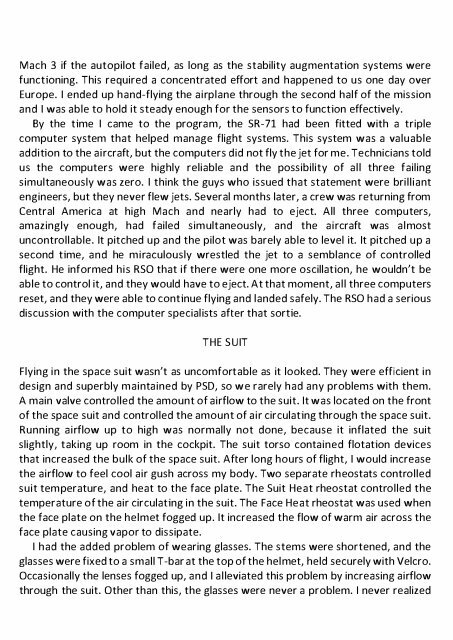Create successful ePaper yourself
Turn your PDF publications into a flip-book with our unique Google optimized e-Paper software.
Mach 3 if the autopilot failed, as long as the stability augmentation systems were<br />
functioning. This required a concentrated effort and happened to us one day over<br />
Europe. I ended up hand-flying the airplane through the second half of the mission<br />
and I was able to hold it steady enough for the sensors to function effectively.<br />
By the time I came to the program, the SR-71 had been fitted with a triple<br />
computer system that helped manage flight systems. This system was a valuable<br />
addition to the aircraft, but the computers did not fly the jet for me. Technicians told<br />
us the computers were highly reliable and the possibility of all three failing<br />
simultaneously was zero. I think the guys who issued that statement were brilliant<br />
engineers, but they never flew jets. Several months later, a crew was returning from<br />
Central America at high Mach and nearly had to eject. All three computers,<br />
amazingly enough, had failed simultaneously, and the aircraft was almost<br />
uncontrollable. It pitched up and the pilot was barely able to level it. It pitched up a<br />
second time, and he miraculously wrestled the jet to a semblance of controlled<br />
flight. He informed his RSO that if there were one more oscillation, he wouldn't be<br />
able to control it, and they would have to eject. At that moment, all three computers<br />
reset, and they were able to continue flying and landed safely. The RSO had a serious<br />
discussion with the computer specialists after that sortie.<br />
THE SUIT<br />
Flying in the space suit wasn't as uncomfortable as it looked. They were efficient in<br />
design and superbly maintained by PSD, so we rarely had any problems with them.<br />
A main valve controlled the amount of airflow to the suit. It was located on the front<br />
of the space suit and controlled the amount of air circulating through the space suit.<br />
Running airflow up to high was normally not done, because it inflated the suit<br />
slightly, taking up room in the cockpit. The suit torso contained flotation devices<br />
that increased the bulk of the space suit. After long hours of flight, I would increase<br />
the airflow to feel cool air gush across my body. Two separate rheostats controlled<br />
suit temperature, and heat to the face plate. The Suit Heat rheostat controlled the<br />
temperature of the air circulating in the suit. The Face Heat rheostat was used when<br />
the face plate on the helmet fogged up. It increased the flow of warm air across the<br />
face plate causing vapor to dissipate.<br />
I had the added problem of wearing glasses. The stems were shortened, and the<br />
glasses were fixed to a small T-bar at the top of the helmet, held securely with Velcro.<br />
Occasionally the lenses fogged up, and I alleviated this problem by increasing airflow<br />
through the suit. Other than this, the glasses were never a problem. I never realized


